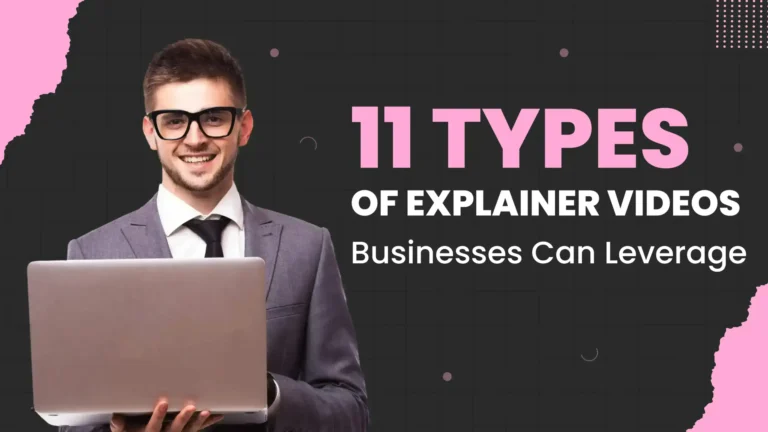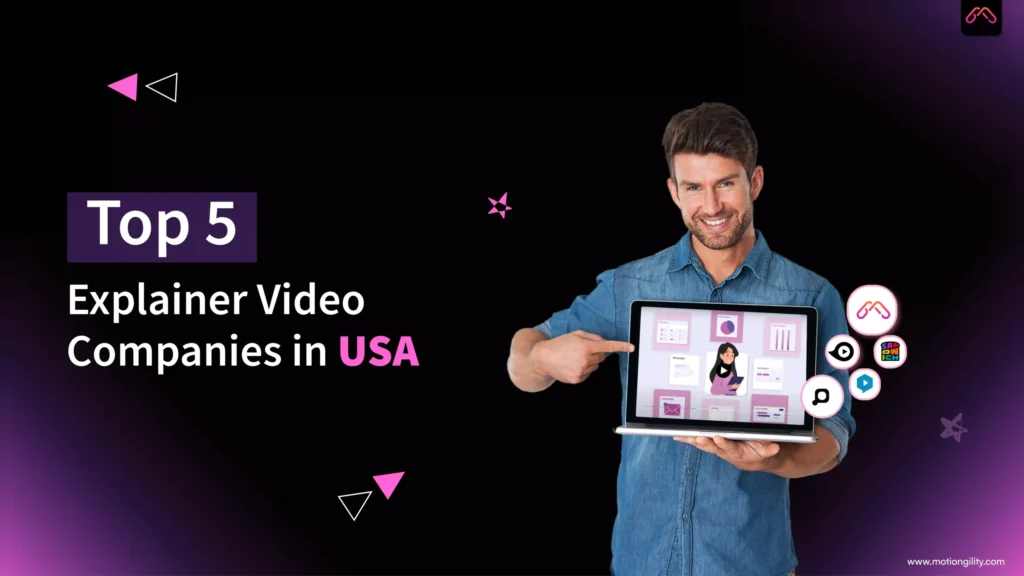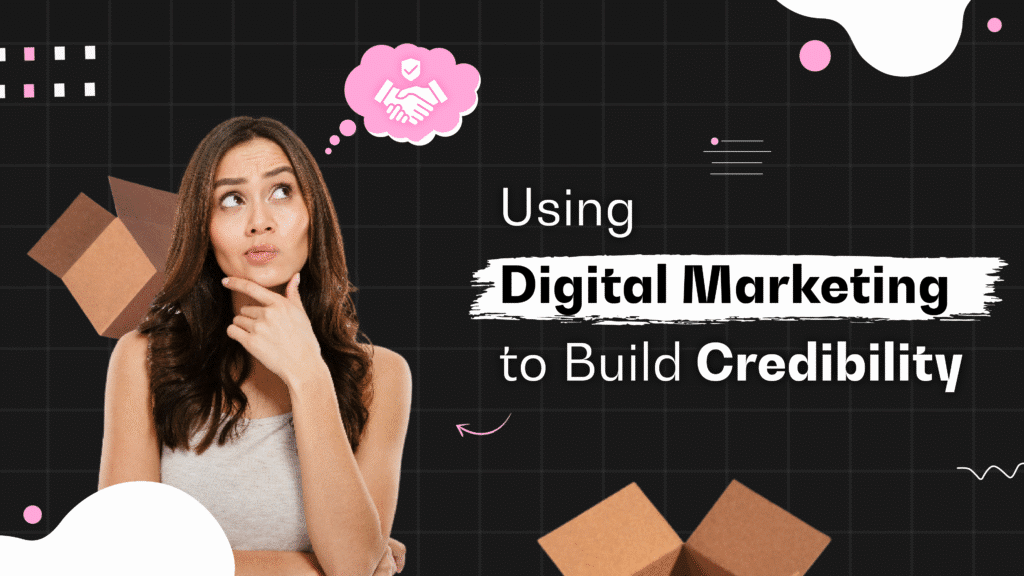Explaining your business in a way that aligns with your audience isn’t always easy.
Long blog posts? Static infographics? They no longer help – especially when attention spans are going down.
That’s where explainer videos escort you.
They simplify your complex ideas into engaging and easy-to-digest stories. But here’s where things get interesting because not all explainer videos are built the same.
There are numerous types of explainer videos out there, and choosing the right style can enhance your message delivery.
So, in today’s article, let’s understand 11 types of explainer videos you can use to connect with your audience and boost conversions.
11 Types of Explainer Videos
Below is the list of 11 types of explainer videos you can leverage to boost your business growth.
1. 2D Animation
2D animation is the classic explainer video style.It’s flat, cartoon-style animation that moves characters and objects across a two-dimensional plane.
This style uses colorful illustrations, smooth transitions, and engaging characters to tell your story. If you’re explaining complex software features or abstract concepts, 2D animation makes everything digestible.
It’s also budget-friendly, which makes it ideal for small businesses testing the explainer video waters.
2. 2.5D Animation
2.5D animation means taking flat 2D elements and adding depth and movement to mimic a 3D effect through layering and perspective tricks.
You’ll see characters and objects that appear to have depth and can rotate slightly, but they’re still essentially flat graphics arranged in 3D space.
2.5D animation explainer videos look dynamic than basic 2D but without the heavy production cost of full 3D.
Companies love this style because it feels professional and modern without being too flashy.
3. 3D Animation
3D animation creates realistic-looking characters, objects, and environments that can move and rotate in three-dimensional space.
This style offers unlimited creative possibilities and is visually stunning but also resource-heavy.
3D animation explainer videos are perfect for companies with larger budgets who want to make a serious impression.
4. Motion Graphics Explainer
What is Motion graphics? It basically means graphics in movement.
In these types of explainer videos, you’ll find graphic elements, typography, and icons floating across the screen rather than characters or storylines.
It’s all about making your information visually compelling through movement and design.
If your explainer video script is heavy on facts and figures, motion graphics can be the best option to make it all come alive.
5. Kinetic Typography
This is where text becomes the center point of your explainer video.
Kinetic typography explainer videos use animated text and letters to convey your message.
While watching such videos, you’ll find words jumping and sliding to stress key points and create visual interest.
It’s a minimalist way to present your message.
6. Whiteboard Animation
Picture someone drawing your entire story on a whiteboard in real-time. That’s what a whiteboard animation explainer video is.
Simply, a hand appears on screen, sketching illustrations, diagrams, and text as the explainer video voice-over continues.
These types of explainer videos feel personal and educational simultaneously because you are watching a story literally unfolding before your eyes.
Whiteboard animation videos are perfect for educational content, training videos, and complex process explanations.
7. Isometric Style
Isometric animation explainer videos use angled 2D graphics to create a 3D-like world.
While watching these videos, you’ll find that everything is viewed from a specific angle (usually from above and to the side), creating the illusion of depth while maintaining clean, geometric shapes.
Isometric explainer videos are the best choice to show your product’s workflow and system architecture appealingly.
8. Screencast / Screen Capture Explainer
Sometimes the best way to explain software is to literally show it in action.
Screencast explainers record actual software interfaces, with cursor movements, clicks, and navigation to give a demo of exactly how something works.
These types of explainer videos are often combined with animations and voice-over to guide viewers through each step.
Screencast videos are best for SaaS companies and businesses offering digital tools or platforms to show how their software works.
9. Live-Action Explainer
Live-action explainer videos use actual filming with human actors to tell your story. This might include talking heads, demonstrations, or full narrative scenes.
The presence of real people in these types of videos creates strong emotional connections, though it requires more planning and production budget.
Live-action videos are perfect for service-based businesses, healthcare providers, restaurants, and companies where human connection is crucial.
10. Mix Media Explainer Videos
Why choose just one style when you can combine the best of multiple video approaches?
Mix media explainer videos include different animation styles, live-action footage, and graphics to create a unique and dynamic presentation for your product.
In these types of explainer videos, you might see 2D animation combined with real photography, or live-action footage enhanced with animated graphics and effects.
11. Stop Motion Explainer Videos
Stop motion explainer videos use real objects moved frame by frame to create animation.
They have a handmade, creative feel that instantly grabs attention, but creating stop motion videos is time-consuming because for each frame, you need a scene.
This style is perfect if you want your brand to look playful, unique, and memorable.
Businesses use it to showcase products, tell fun stories, or stand out in a crowded market
Conclusion
Explainer videos aren’t one-size-fits-all.
Choosing the right style depends on your goals, audience, and budget. 2D and motion graphics are more cost-effective, while 3D and live-action need larger investments.
Some types of explainer videos take longer to produce, and your choice should match your brand’s personality and message complexity.
You should choose the style wisely, and you’ll have a video that engages, educates, and converts.
If you’re not sure which style suits you best, don’t worry – that’s where we come in.
At MotionGility, we help businesses like yours pick the right explainer video services and turn complex ideas into videos that drive results.
Get in touch with us for an affordable explainer video for your brand.
FAQs about Types of Explainer Videos
1. Which type of explainer video is most popular?
Ans: 2D animation and motion graphics are the most widely used explainer videos because of their versatility and affordability.
2. How long should an explainer video be?
Ans: Most effective explainer videos range between 60-90 seconds. They’re long enough to explain and short enough to keep attention.
3. Are explainer videos worth the investment?
Ans: Absolutely. They improve engagement, simplify messaging, and boost conversions better than text or images alone
4. Can I mix different types of explainer videos?
Ans: Yes, mix media explainer videos combine live-action, animation, or motion graphics for maximum impact.





